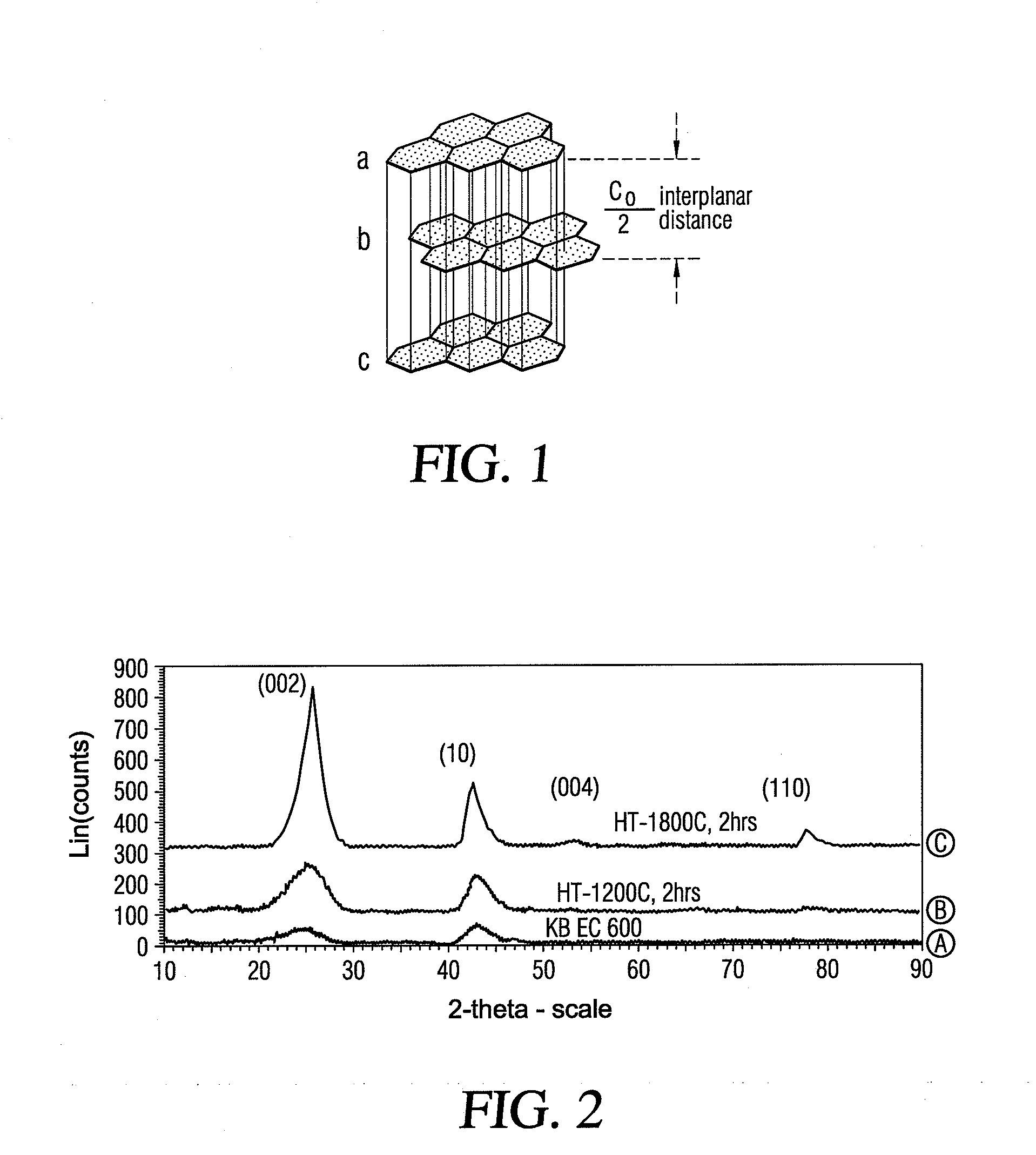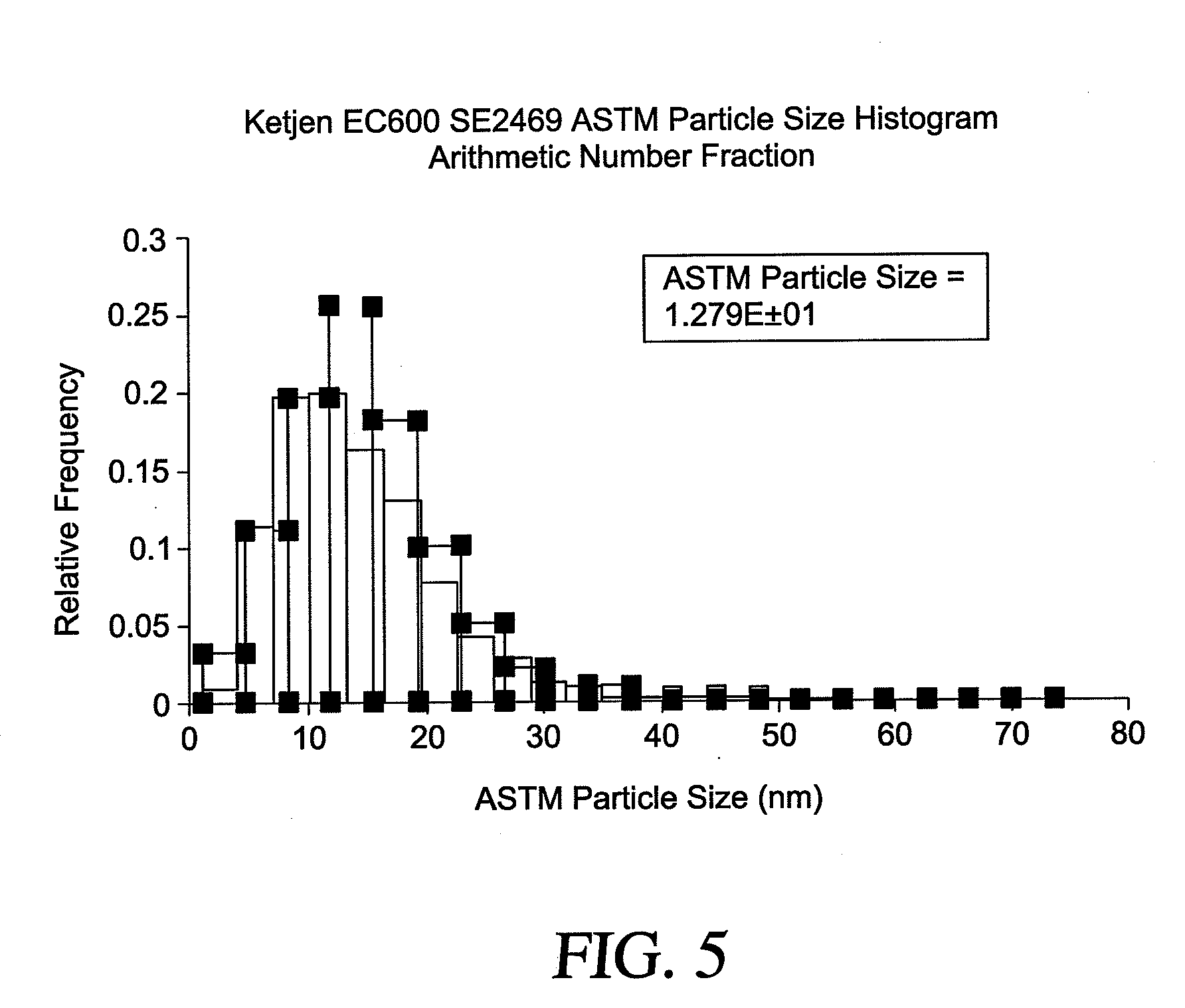High surface area graphitized carbon and processes for making same
a graphite carbon and high surface area technology, applied in the field of graphite carbon, can solve the problems of major challenges in the durability of commonly used carbon supports, and achieve the effect of high surface area
- Summary
- Abstract
- Description
- Claims
- Application Information
AI Technical Summary
Benefits of technology
Problems solved by technology
Method used
Image
Examples
example 1
Preparation of High Surface Area Carbon with Vulcan VXC72® by Etching
[0128]21.8 kg of carbon black VXC72® (Cabot Corp.) pellets were loaded into a fluidized bed reactor (see FIG. 6 for a flow diagram of a steam etching system), and the bed was purged with nitrogen through a gas pre-heater while the bed was being heated up. After the bed temperature reached the set point of about 950° C., steam was introduced into the reactor from a steam generator and the steam etching process began. In this example, pure steam was employed, although in other embodiments, a nitrogen line may remain partially open during the process, depending on the desired steam etching conditions. The steam flow rate was 6.9 kg / hr, and the ratio of steam to carbon (kg steam per hour to total carbon (kg)) was 0.32 kg / hr / kg, which provided desirable fluidization characteristics for the carbon black pellets. After 245 minutes, the steam etching process was stopped and the resulting etched carbon was characterized. B...
examples 2a & 2b
Preparation of High Surface Area Carbon Blacks with BP700 (Ex. 2A) and BP800 (Ex. 2B) by Steam Etching
[0130]Under similar processes as described in Example 1, carbon blacks having different properties, BP700® and BP800®, were employed in the steam etching process. The steam etching conditions are listed in Table 2. The BET surface area, pore volume and average pore size of the resulting etched carbons are listed in Table 2, together with the properties of the original carbon blacks. The BET surface areas of the steam-etched samples had an about 8 fold increase in surface area relative to their parent carbon blacks.
TABLE 2STEAM ETCHING CONDITIONSVXC-72, BP700 & BP800SteamSteamBETrate@CarbonSteametchingsurfacePorePore950° C.loadingrate / CarbontimeareavolumediaPowder(kg / hr)(kg)(Kg / hr / Kg)(min)(m2 / g)(cc / g)(nm)VXC-72 (Parent)179.40.4148.46(5% PEG)Example 16.921.80.32245885.31.235.47SE-VXC-72BP700 (Parent)244.11.0415.4Example 2A3.8120.322701642.53.88.13SE-BP700BP800 (Parent)236.00.7312.2Ex...
example 3
Heat Treating of Carbon Blacks
[0131]A commercial carbon black, Ketjen black EC600 (KB)®, was treated at elevated temperatures from 1200 to 2700° C. with ramp times of 5-6 hours and dwelled for 2 hrs at the desired temperature under inert gas (N2) atmosphere. The treatment conditions are listed in Table 3. Examples 3A-3F correspond with heat treated samples at 1200° C., 1500° C., 1800° C., 2100° C., 2400° C. and 2700° C., respectively. The d spacing calculated from XRD for Examples 3A-3F were 0.3593 nm, 0.3422 nm, 0.3495 nm, 0.3458 nm, 0.3449 nm and 0.3429 nm, respectively, as compared to the unmeasureable d spacing of its original (“pure” amorphous) KB EC600 powder, revealing that the level of graphitization generally increased significantly after heat treatment. Generally, with increasing treatment temperature, degree of graphitization also increased.
TABLE 3HEAT TREATING CONDITIONSKB EC600 ®BETTotalHeat treatedSurfaceporePoretemperatured spacingAreavolumediameterPowder(° C.)(nm)(m2...
PUM
| Property | Measurement | Unit |
|---|---|---|
| temperature | aaaaa | aaaaa |
| temperature | aaaaa | aaaaa |
| temperature | aaaaa | aaaaa |
Abstract
Description
Claims
Application Information
 Login to View More
Login to View More - R&D
- Intellectual Property
- Life Sciences
- Materials
- Tech Scout
- Unparalleled Data Quality
- Higher Quality Content
- 60% Fewer Hallucinations
Browse by: Latest US Patents, China's latest patents, Technical Efficacy Thesaurus, Application Domain, Technology Topic, Popular Technical Reports.
© 2025 PatSnap. All rights reserved.Legal|Privacy policy|Modern Slavery Act Transparency Statement|Sitemap|About US| Contact US: help@patsnap.com



